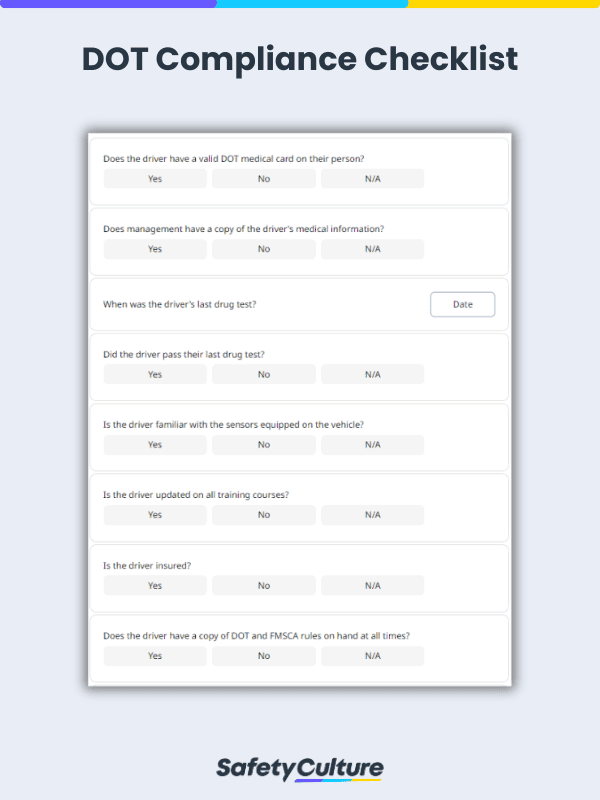What is a DOT Compliance Checklist?
A DOT compliance checklist is a document used by commercial fleet managers and truck operators to ensure they meet the safety and operational requirements set by the US Department of Transportation (DOT). This checklist encompasses different areas of transportation and safety management, such as driver qualifications, vehicle maintenance, hours of service, drug testing, and license and permit management.
Importance
The main purpose of a DOT compliance checklist is to ensure the safety of drivers, passengers, and the public. DOT compliance ensures that vehicles meet all required safety standards before hitting the road, reducing the risk of accidents due to faulty maintenance or equipment failure.
Additionally, the US DOT, along with the US Federal Motor Carrier Safety Association (FMCSA), often conducts random safety checks on fleets. Using a dedicated compliance checklist helps ensure you are prepared for this at all times.
Using a DOT compliance checklist also ensures that you and your fleet are following road regulations, legal standards, and commercial laws. It can help avoid common violations ranging from operating without the required qualifications to unsafe transportation of hazardous materials, all of which can result in significant financial repercussions.
By adhering to these regulations, companies demonstrate their commitment to safety, professionalism, and legal compliance, which is essential for the smooth operation of commercial fleets.
What to Include in a DOT Compliance Checklist
To ensure your commercial fleet is compliant with DOT and FMCSA standards, your DOT compliance checklist should include fields for the following:
- Date of audit
- Name of the auditor or inspector
- Name of the driver being audited
- The driver’s qualifications, such as:
- Their latest medical exam results
- Their latest drug exam status
- Their insurance
- Their training credentials
- Verification of the driver being aware of DOT guidelines
- Verification of the driver being knowledgeable on how to handle hazardous materials (if needed)
- Verification that the driver follows their Hours of Service (HOS) as set by the US DOT
- General vehicle inspection
- Specific vehicle inspection focused on its parts
The DOT compliance checklist should then be finished with a section to list additional comments and recommendations. After this, the assigned inspector or auditor should sign off on the checklist to ensure the validity of the document.
Here is a DOT compliance checklist in use for reference:
How to Ensure Compliance with DOT and FMCSA Standards
In addition to using a dedicated compliance checklist for DOT and FMCSA standards, you can also do the following to ensure compliance:
Provide regular training sessions.
The US DOT and FMCSA encourage regular training sessions to be provided to vehicle maintenance workers, fleet managers, and drivers to ensure road safety at all times. Proper training and refresher courses prepare all fleet workers with the right experience, confidence, and skills to effectively make decisions on the roads, leading to a safer experience for all.
Utilize sensors inside vehicles.
As of 2015, the US DOT and FMCSA have required the use of Electronic Logging Devices (ELD) for all fleet managers in their vehicles. These devices are sensors that monitor both drivers and vehicles. For drivers, these sensors monitor their time on the road. Meanwhile, for vehicles, they monitor their distance traveled, current location, and hours of operation.
Also called electronic logbooks, fleet managers now use these to keep track of their drivers’ HOS and their vehicles’ working conditions. These monitoring devices can also be supplemented with other sensors for maximum safety.
Use cloud storage.
Many documents are required for DOT compliance, which can be hard to manage. For this reason, different fleet managers often collate all documents into a binder for easy reference. However, these paper-based files can be difficult to manage and extract data from over time.
A more efficient alternative for recordkeeping is using digital cloud storage. Keeping all your documents in the cloud lets you and your drivers easily access your checklists and other files, anytime and anywhere.
In addition, it would be beneficial if your cloud storage could also maintain a log of your telematics data, making it easier to collate the necessary information for proving compliance.
FAQs about DOT Compliance Checklists
Yes, you can use other safety and transport checklists to supplement your DOT compliance checklists to ensure the best working conditions for you, your drivers, and your vehicles. Some additional checklists you can use are:
In addition to compliance checklists, you should always have the following on hand:
- Driver qualification documents
- Annual list of violations, if any
- Annual reviews of drivers’ performances
- Medical records and drug records of all drivers
- Safety certifications
- HOS records
- Vehicle maintenance and inspection records
- Evidence of an inspector’s qualifications
Since the US DOT performs compliance checks randomly, you can be caught at a time when you are not ready or are not compliant with their standards yet. In case you fail a DOT compliance review or cannot provide the necessary documentation, your company may be fined, suspended, or both.




